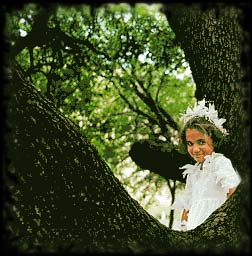
 |
When I feel sad inside
|
He has an understanding soul...Opal Whiteley grew up in Oregon lumber camps around the turn of the century. A lonely child, she befriended the plants and animals who lived nearby. Her empathetic nature allowed her to commune with insects and trees, with stars and the wind and the rain, as well as with animals -- and she tells us of them all in her diary, begun when she was about six years old. Her cast of characters ranges from Brave Horatius the dog to "lichen folks" who "talk in grey tones" — from the woodrat, Thomas Chatterton Jupiter Zeus, to "a choir with a goodly number of folks in it, all potato folks wearing brown robes." Her comforters include the sympathetic (human) neighbor, Sadie McKibben, and Opal's "grand tree," Michael Raphael. She wrote phonetically in childish capitals with no punctuation or breaks between words on paper bags and scraps of wrapping paper, using a single crayon until it was worn completely away and "the fairies" brought her a new one. Eventually her sister tore the diary into tiny pieces, but Opal gathered up the pitiful fragments and saved them. In 1919 she met Ellery Sedgwick, the editor of The Atlantic Monthly, when she was trying to publish a children's book. Sedgwick was more impressed with the writer's own story than by her manuscript, and he asked her if she had ever kept a diary. Opal burst into tears and told him of her box of torn-up bits. The editor persuaded her to send for the box, and put her up at his mother's home for nine months while she laboriously pieced the minute fragments back together. The diary was serialized in The Atlantic Monthly in 1920, and a limited edition book was published, with much acclaim. But the fickle critics soon denounced her as a fraud, concluding that no child of six could have written so luminously. Rejected by her family and alone, she slipped into poverty and was institutionalized after some friends who had given her money for food found her near starvation, having bought books instead. She remained institutionalized until her death in 1992. A new edition for children was published in by Philomel Books in 1994 (reissued by Paperstar in 1997), entitled Only Opal: The Diary of a Young Girl with illustrations by Caldecott medalist Barbara Cooney. Now a new generation is discovering Opal Whiteley's keenly observed, poignantly felt, and poetically drawn observations of the natural world. Hugh Chandler's composition, Opal's Book, scored for soprano, flute, and piano, was begun in 1994. Springkeeper premièred the first four movements at Central Presbyterian Church's noon concert series in Austin, Texas, on September 1, 1994. Two additional movements, composed in 1998, were premièred by Springkeeper on June 6,1998, at the Austin Mostly Music Marathon (benefiting AIDS Services of Austin). Hugh Chandler composed a final movement in November 2001 which was premièred at Third Place Books in Seattle, Washington, on December 9, 2001.
|
The Diary of Opal Whiteley, from the University of Oregon
Opal Whiteley, an online book by Steve McQuiddy.
The Fairyland Around Us, by Opal Whiteley
![]()